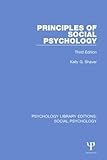Principles of social psychology Kelly G Shaver
Material type: TextLanguage: English Series: Psychology Library Editions : Social PsychologyPublication details: London : Taylor and Francis, 2015.Edition: 3rd EdDescription: xi, 658 p. ill.; 24 cmISBN:
TextLanguage: English Series: Psychology Library Editions : Social PsychologyPublication details: London : Taylor and Francis, 2015.Edition: 3rd EdDescription: xi, 658 p. ill.; 24 cmISBN: - 9781138858305
- 302 SHA
| Item type | Current library | Collection | Call number | Status | Date due | Barcode |
|---|---|---|---|---|---|---|
 General Books
General Books
|
CUTN Central Library Social Sciences | Non-fiction | 302 SHA (Browse shelf(Opens below)) | Available | 29841 |
CHAPTER ONE SOCIAL PSYCHOLOGY: ACCOUNTING FOR SOCIAL BEHAVIOR; What Kind of Explanation?; Observation and Theory; Constructing a Definition of Social Psychology; Plan of the Book; Suggested Additional Readings; CHAPTER TWO THEORY AND METHOD; Assumptions of Social Psychology; Definitions, Operations, and Replication; Validity of the Research Method; Reactivity in Social Psychological Research; Archival Methods: History as Social Psychology; Observational Methods: Behavior in Public Places. Precursors to Laboratory ExperimentationThe Laboratory Experiment; Comparisons Among Methods; Summary; Suggested Additional Readings; CHAPTER THREE ELEMENTS OF SOCIAL PERCEPTION; Person Perception and Object Perception: A Difference in Degree or a Difference in Kind?; Description of the Stimulus in Person Perception; Nonverbal Mediators in Person Perception; Accuracy in the Judgment of Others; The Stimulus as Person: Self-Presentation; Summary; Suggested Additional Readings; CHAPTER FOUR SOCIAL COGNITION: CONSTRUCTION OF SOCIAL REALITY; Gathering Information. Categorization: The Organization of the Social WorldSocial Inference: Searching for Causes of Behavior; Combination of Information: Impression Formation; Summary; Suggested Additional Readings; CHAPTER FIVE ATTITUDE ORGANIZATION AND COGNITIVE CONSISTENCY; THE PROBABILOGICAL MODELS OF ATTITUDE ORGANIZATION; The Syllogistic Model; The Information-Processing Model; THE PRINCIPLE OF COGNITIVE CONSISTENCY; Cognitive Consistency; Relations Among Cognitive Elements; Balance Theory; Congruity Theory; Cognitive Dissonance Theory; Summary; Suggested Additional Readings. CHAPTER SIX PERSUASION AND ATTITUDE CHANGEThe Attitude of Racism; General Issues in Attitude Change; Sources of Resistance to Attitude Change; Sources of Facilitation; Ethical Issues in Attitude Change; Summary; Suggested Additional Readings; CHAPTER SEVEN THE SELF; The Self as Content and Process; The Process of Self-Evaluation; The Development of Self-Esteem; The Public Self: Mask or Reality?; Summary; Suggested Additional Readings; CHAPTER EIGHT REINFORCEMENT AND FAIRNESS IN SOCIAL EXCHANGE; Rewards and Social Learning; Exchange Theory; Fairness in Social Exchange; Summary. Suggested Additional ReadingsCHAPTER NINE POSITIVE FORMS OF SOCIAL BEHAVIOR; ALTRUISM AND HELPING BEHAVIOR; The Problem of Definition; Objective Altruism in Nonemergency Situations; Objective Altruism in Emergencies; INTERPERSONAL ATTRACTION; An Attitude of Favorability; Emotion and Commitment; The Measurement of Attraction; Some Antecedents of Attraction; Summary; Suggested Additional Readings; CHAPTER TEN COMPETITION AND AGGRESSION; Experimental Methods for the Study of Competition; Achievement Motivation and Competition; The Definition of Aggression.


There are no comments on this title.